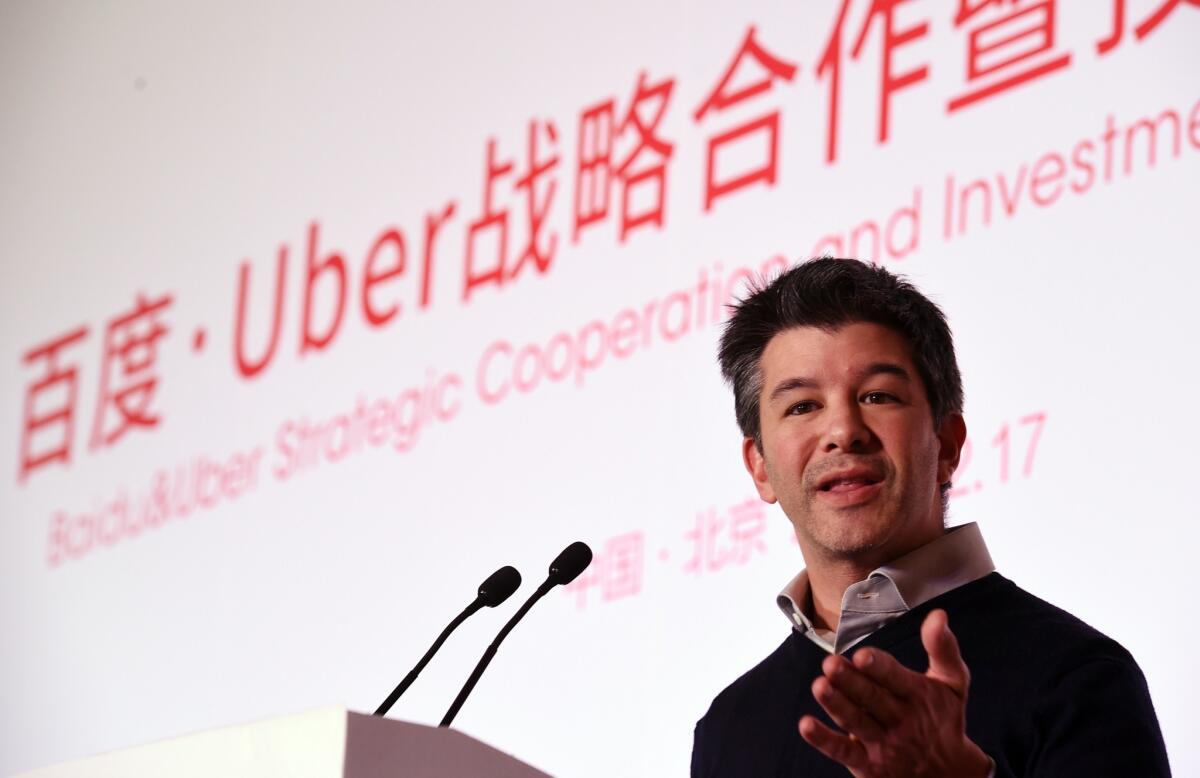Has Uber already peaked?

Uber Chief Executive Travis Kalanick in Beijing last December, announcing an agreement with Chinese search engine Baidu.
- Share via
The ride-hailing service Uber is unquestionably one of the defining phenomena of our digital era. But much of the excitement it generates in the investment community comes from the notion that its growth is unstoppable -- that sooner or later Uber will, well, reign uber alles.
Indications are emerging, however, that Uber’s growth faces some genuine natural limits. That’s the argument being made by Frederick Steier of TheStreet.com and Lawrence Meyers, chief executive of Los Angeles-based PDL Capital, a firm that finances pay day lending, auto title lending, and other “specialty” loan businesses.
Their take is that in New York, Uber and the medallion taxi fleet “may have arrived at a natural equilibrium” (Steier’s words) that will prevent Uber from growing much more in that city. Meyers wrote recently in the New York Observer that, based on Uber’s figures, “the land grab is clearly over. ... At this point, Uber drivers are as likely to cannibalize each other than steal taxi medallion market share.”
That’s a finding likely to apply to other communities, and conforms to the anecdotal information I gleaned from Uber drivers in San Francisco and Washington, D.C., this summer: They weren’t making much money, in part because Uber had signed up too many cars to serve a finite demand profitably. One of our drivers had been forced out of the taxi business by competition from Uber drivers, then joined Uber only to find that he was still facing competition from Uber drivers.
Uber says it hasn’t yet come close to reaching its market potential. “There’s plenty of opportunity for growth,” company spokesman Michael Amodeo told me. “There’s still a lot of potential demand out there and we will continue to see that for some time.” The idea is that even in communities where Uber is established, customers are still finding ways to substitute the company’s service for the cost and hassle of owning their own cars.
Meyers based his conclusions on Uber figures indicating that although the company has signed up 20,448 cars in New York, only about 3,220 are on the streets at any given time. The New York Daily News quoted Uber officials saying that only 2,000 cars were operating in Manhattan’s central business district (that’s from Wall Street to 96th St.) between 7 a.m. and 7 p.m. Meyers concludes that Uber took about 10% of the business away from yellow cabs in Manhattan, but that it’s hard to see where further inroads will come from.
Where are the other drivers? Some might be at home, pondering how hard it is to make a decent buck as an Uber driver.
It’s becoming plain that drivers tend to seriously underestimate their own expenses, at least at first, when calculating their potential take from Uber. They’re aware of Uber’s 20% commission, and in New York they may also know that they’ll owe city sales tax (8.15%) and a transportation fund tax of 2.44%, on their fares. (Total off the top: 30.59%.)
But are they accurately calculating gas, insurance, and wear-and-tear? Probably not. Those can add more than $12,000 to the cost of a vehicle over time, Meyers calculates in a white paper on the income of New York City Uber drivers. If the car is regularly used to ferry passengers, it will have a shorter lifespan than a civilian car -- perhaps less than four years for a full-time commercial driver compared to more than 11 years for the average car. So an Uber driver will have to replace his or vehicle in about one-third the time of a normal commuting and pleasure car owner.
Meyers figures that drivers lose 69% of their first dollar per mile and 49% of the second to expenses, before taxes. It takes time and experience to figure out that what’s left may be the equivalent of minimum wage, or even less. But eventually many drivers do, which may be why a huge percentage, perhaps nearly half, bail out within a year of starting. A study released by Uber in January said, carefully, that “more than half of those who started in the first half of 2013 remained active a year after starting.” (How much more?)
Indeed, evidence of driver discontent is spreading. Earlier this month Uber drivers in Dallas staged a walkout to protest their low income, following protests last year in Seattle, San Francisco, Los Angeles, and other cities.
None of this means that Uber doesn’t serve a sizable market or substitute for incumbent taxis in ways that serve residents and its own drivers alike. Its cars are easy to hail and, in communities where they’re plentiful, quick to show up. Often they undercut taxi fares, sometimes by a lot. And they may be more likely to serve underserved communities, including neighborhoods far from the city center, and to be available at crush times or big events.
Meyers’ calculations undoubtedly can be quibbled with, but his point is worth considering by investors as well as municipal officials and taxi magnates trying to figure out what to do when Uber comes to town. It may help them understand why it makes sense to enact rules that protect their incumbent taxi fleets from wholesale destruction by Uber, albeit without shutting Uber entirely out of the business.
But the indications that Uber can’t grow forever should give pause to investors, who may otherwise be inclined to price the company for perfection. Uber faces plenty of headwinds, including local transportation rules, labor regulations that may force it to pay drivers like employees, rather than independent contractors, and the cost of competition. The question of what Uber really is worth remains open.
Keep up to date with the Economy Hub. Follow @hiltzikm on Twitter, see our Facebook page, or email [email protected].







